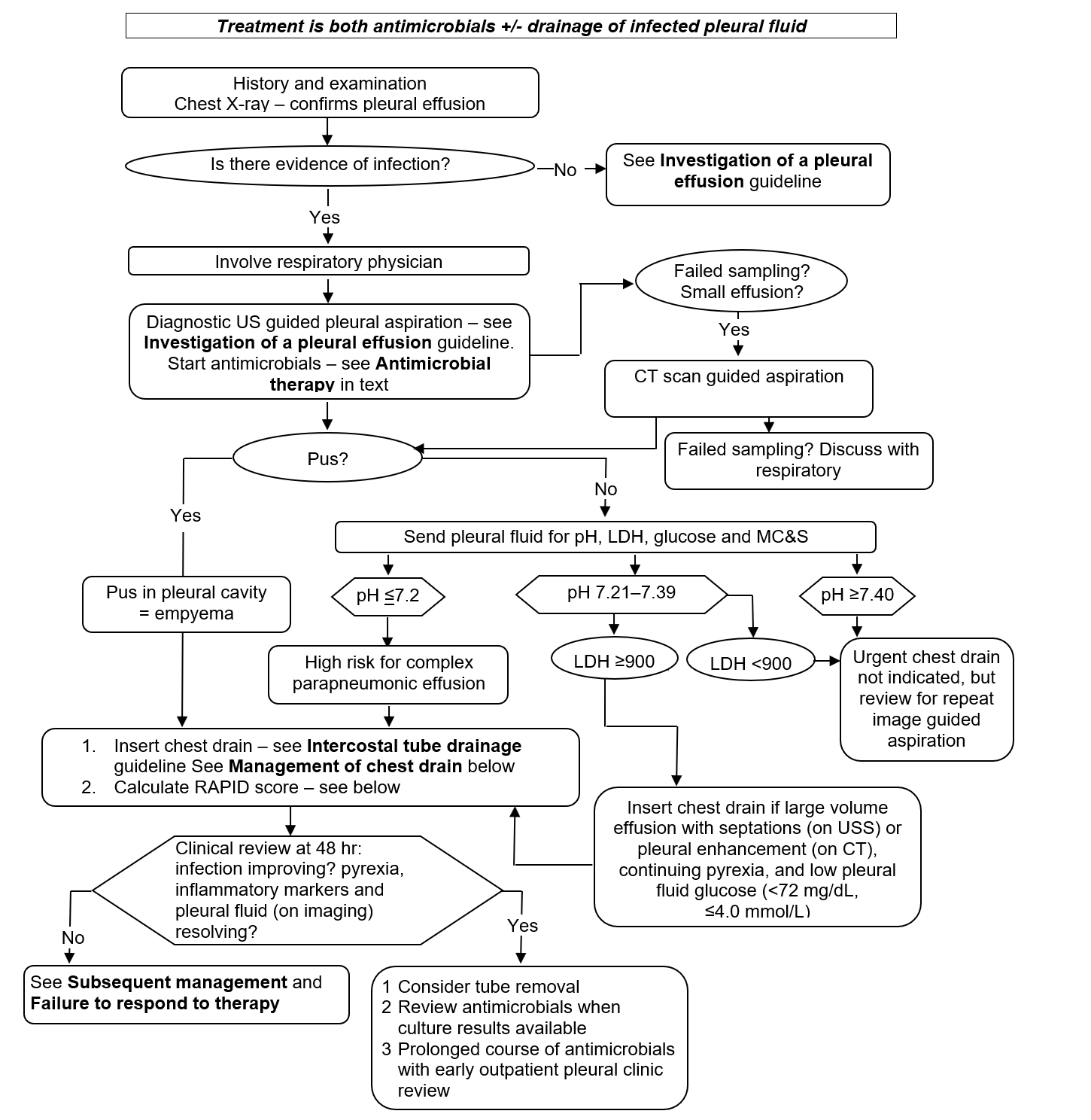DO NOT USE - ALL INFORMATION LIKELY INCORRECT IF NOT ACTIVELY DANGEROUS
Please use current guidelines available on the UHNM intranet for patient treatment
Please use current guidelines available on the UHNM intranet for patient treatment
RECOGNITION AND ASSESSMENT AND INITIAL MANAGEMENT
Suspected pleural infection - management algorithm
Antimicrobial therapy
- Unless absolutely impossible, send sample of fluid for culture before starting antimicrobial therapy
- If microbe known, follow advice of microbiologist / ID consultant
- Otherwise start empirical therapy while awaiting results of culture
Infection Control alerts
- Check for IC alert
- if IC alert not available, check previous 12 months of microbiology reports
- If MRSA present, treat as tagged for MRSA. See MRSA management
- if ESBL, MGNB, CARB present, treat as tagged for ESBL. See ESBL/MGNB/CARB management
Penicillin Allergy
- True penicillin allergy is rare
- Ask the patient and record what happened when they were given penicillin
- If any doubt about whether patient is truly allergic to penicillin, seek advice from a microbiologist or consultant in infectious diseases
Accept penicillin allergy as genuine hypersensitivity only if history of either rash within 72 hr of dose or anaphylactic reaction is convincing
Empirical antimicrobial regimen
- First line: Co-amoxiclav 1.2 g IV 8-hrly. Alternative (true penicillin allergy): Levofloxacin 500 mg IV by infusion 12-hrly plus metronidazole 500 mg IV by infusion/or 400 mg oral 8-hrly
- if patient tagged for MRSA, add vancomycin IV by infusion (see Vancomycin guideline and calculator)
- if MRSA proven (cultured in pleural fluid) or likely cause of empyema (e.g. recent relevant specimen other than pleural fluid positive for MRSA): Discuss use of additional antimicrobial (e.g. rifampicin) with microbiologist/ID Consultant
SUBSEQUENT MANAGEMENT
- Nutritional support in prolonged illness
Management of chest drain
- Ensure chest tube is draining freely and the tube is swinging at all times.
- If small bore (12-18 F) catheter is not draining freely, use the 3-way tap to flush with sodium chloride 0.9% 30 mL every 6-8 hrly
- No flushing required for larger bore drains
Removal of tube
- Remove chest drain when the patient better with:
- infection improving and
- CXR showing fluid drained almost completely
Oral antimicrobials
- Change to oral as soon as clinical improvement occurs and temperature normal for 24 hr
- providing there is no contra-indication to oral therapy and sensitivities allow
- Use oral antimicrobial to which microbe sensitive with good tissue penetration
- if not known or in doubt, discuss with microbiologist or consultant in infectious diseases
Duration of antimicrobials
- ≥3 weeks: continue antimicrobial therapy for a prolonged period of time
- usually at least until all fluid has gone and drain has been removed
- Monitor patient closely for recurrence after stopping treatment
Calculating RAPID score
- Renal, age, purulence, infection source, dietary factors
- For risk stratifying and inform discussions with patients regarding potential outcome from pleural infection
- Higher RAPID scores appear to indicate an increased risk of mortality and may indicate an increased length of hospital stay
| Parameter | Measure | Score |
| Renal |
Serum urea <5.0 5.0-8.0 >8.0 |
0 1 2 |
| Age |
<50 yr 50-70 yr >70 yr |
0 1 2 |
| Purulence of pleural fluid |
Purulent Non-purulent |
0 1 |
| Infection source |
Community acquired Hospital acquired |
0 1 |
| Dietary factors |
Serum albumin (g/L) ≥27.0 <27.0 |
0 1 |
| Risk category |
Score 0-2 Score 3-4 Score 5-7 |
Low risk Medium risk High risk |
Failure to respond to therapy
- Review by respiratory consultant/consultant in infectious diseases
- Repeat chest X-ray and thoracic ultrasound and if required, CT scan
- Check tube and fluid drainage
- Review antimicrobials when culture results become available and discuss with microbiology
- Discuss with respiratory to advise further management:
- large bore chest tube if poor drainage despite presence of fluid
- intrapleural tissue plasminogen activator (TPA) 10 mg diluted with sodium chloride 0.9% 30 mL twice daily (if risk of bleeding use 10 mg twice daily) plus DNase 5 mg diluted with sodium chloride 0.9% 30 mL twice daily for 3 days. Instil TPA, followed by DNase and then sodium chloride flush
- clamp drain for 1 hr after each instillation
- if TPA or DNase not suitable - intrapleural sodium chloride irrigation
- prolonged indwelling catheter
- discussion with thoracic surgery for suitability for video assisted thoracic surgery (VATS)
DISCHARGE AND FOLLOW-UP
- Discharge when chest drains removed and clinical variables stable
- Continue antimicrobials for at least 3 weeks after initiation
- Follow all up patients in respiratory clinic with Chest X-ray about 3-4 weeks after discharge
Last reviewed: 2024-03-20
